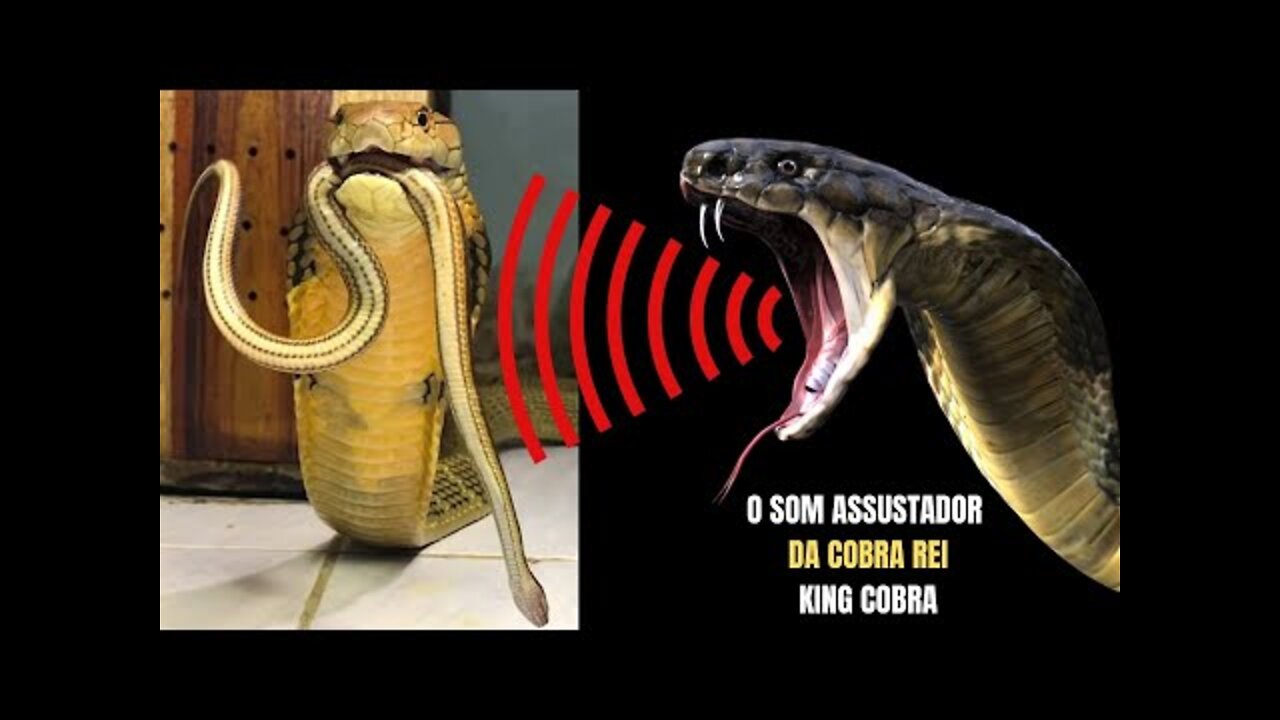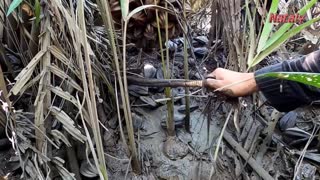Premium Only Content

O som assustador da Cobra Rei | @Diaz Borneo | Biólogo Henrique
Vídeo original do canal @Diaz Borneo
The king cobra (Ophiophagus hannah) is a large elapid endemic to forests from India through Southeast Asia. It is the world's longest venomous snake.[2] Adult king cobras are 3.18 to 4 m (10.4 to 13.1 ft) long on average. The longest known individual measured 5.85 m (19.2 ft).[3] It is the sole member of the genus Ophiophagus. It preys chiefly on other snakes and occasionally on some other vertebrates, such as lizards and rodents. It is a highly venomous and dangerous snake when agitated or provoked that has a fearsome reputation in its range, although it is typically shy and avoids confrontation with humans when possible.
The king cobra is a prominent symbol in the mythology and folk traditions of India, Sri Lanka and Myanmar.[6][7] It is the national reptile of India.[8] It is threatened by habitat destruction and has been listed as Vulnerable on the IUCN Red List since 2010
Hamadryas hannah was the scientific name used by Danish naturalist Theodore Edward Cantor in 1836 who described four king cobra specimens, three captured in the Sundarbans and one in the vicinity of Kolkata.[9] Naja bungarus was proposed by Hermann Schlegel in 1837 who described a king cobra zoological specimen from Java. In 1838, Cantor proposed the name Hamadryas ophiophagus for the king cobra and explained that it has dental features intermediate between the genera Naja and Bungarus.[11] Naia vittata proposed by Walter Elliot in 1840 was a king cobra caught offshore near Chennai that was floating in a basket. Hamadryas elaps proposed by Albert Günther in 1858 were king cobra specimens from the Philippines and Borneo. Günther considered both N. bungarus and N. vittata a variety of H. elaps.[13] The genus Ophiophagus was proposed by Günther in 1864. The name is derived from its propensity to eat snakes.
Naja ingens proposed by Alexander Willem Michiel van Hasselt in 1882 was a king cobra captured near Tebing Tinggi in northern Sumatra.
Ophiophagus hannah was accepted as the valid name for the king cobra by Charles Mitchill Bogert in 1945 who argued that it differs significantly from Naja species. A genetic analysis using cytochrome b,[18] and a multigene analysis showed that the king cobra was an early offshoot of a genetic lineage giving rise to the mambas, rather than the Naja cobras.
fonte : wikipedia
A cobra-real (Ophiophagus hannah) é uma espécie de serpente peçonhenta da família dos Elapídeos, autóctone da Ásia meridional e do sudeste asiático, que habita as planícies e florestas tropicais da Índia e da China, bem entre outras nações do sudeste asiático.
Está ameaçada pela destruição do seu habitat e encontra-se listada como vulnerável na Lista Vermelha da IUCN desde 2010.[4] É a maior cobra peçonhenta conhecida. Cobras-reais adultas normalmente vão de 3 a 4 metros de comprimento, sendo que a maior já registrada chegou a medir 5,85 m.
Apesar de contar com o substantivo "cobra" no nome, esta espécie não pertence ao gênero Naja, mas é o único membro do gênero Ophiophagus.[5] É carnívora e a sua dieta consiste basicamente em outros ofídios, venenosos ou não, mas não despreza lagartos, ovos e pequenos mamíferos.[1][2][6] O nome científico Ophiophagus significa literalmente "comedora de serpentes".
Nomes comuns
Dá ainda pelos seguintes nomes comuns: cobra-reie hamadríade(não confundir com a espécie de macaco Papio hamadryas que com ela partilha este nome
Descrição
A coloração da cobra-real varia do marrom ao preto com listras brancas ou amarelas, ou ainda verde-azeitona sem listras. O pescoço possui uma capa que se expande ao se sentir ameaçada.[6]
As cobras jovens são pretas brilhantes com faixas amarelas estreitas (podem ser confundidos com um krait com faixas, mas facilmente identificados com seu capuz expansível). A cabeça de uma cobra adulta pode ser bastante compacta e volumosa na aparência, embora, como todas as cobras, possa expandir suas mandíbulas para engolir grandes presas. Sua dentição é proteroglífica, o que significa que tem duas presas curtas e não retráteis na frente da boca por onde canalizam o veneno para dentro da presa. A expectativa de vida de uma cobra-real é de cerca de 20 anos.
-
 5:25
5:25
Nataly TV
2 years ago $0.01 earnedGrand cobra
33 -
 3:56:31
3:56:31
JakeParker
3 hours ago $2.13 earnedJakeParker is LIVE on Rumble
22K -
 LIVE
LIVE
SpartakusLIVE
5 hours ago $3.80 earnedThe Duke rallies squad for LAUGHS into the night with a SMATTERING of TOXIC banter
1,606 watching -
 1:03:51
1:03:51
Flyover Conservatives
22 hours agoGeneration Z’s Revolution: 17 Year Old Author on the Return of Faith, Family, and the End of Feminism - Hannah Faulkner; Economic Update - Dr. Kirk Elliott | FOC Show
14.8K -
 1:12:43
1:12:43
Adam Does Movies
7 hours ago $0.10 earnedMoviegoers Are Singing Now! + Lilo & Stitch + Sonic 3 - LIVE!
17.8K1 -
 1:26:05
1:26:05
Donald Trump Jr.
10 hours agoRegime Media Imploding: What’s Next for MSNBC? Plus Michael Knowles & Alex Marlow | TRIGGERED Ep.194
181K165 -
 37:26
37:26
Glenn Greenwald
7 hours agoGlenn Takes Your Questions: On Trump's Cabinet, The G20 Summit, and More | SYSTEM UPDATE LOCALS SPECIAL
57.8K20 -
 LIVE
LIVE
We Like Shooting
14 hours agoWe Like Shooting 586 (Gun Podcast)
151 watching -
 52:14
52:14
Uncommon Sense In Current Times
9 hours ago“Pumpkin Pie Politics: Bridging the Thanksgiving Divide to Protect The Family"
2.62K -
 1:01:28
1:01:28
The StoneZONE with Roger Stone
4 hours agoWhy Jack Smith Owes Americans Millions of Dollars for Fake Investigations | The StoneZONE
24K3